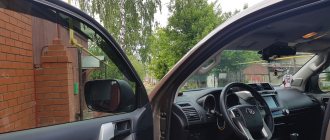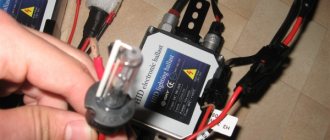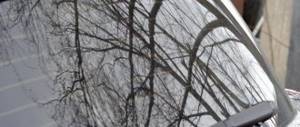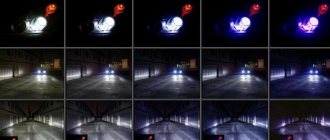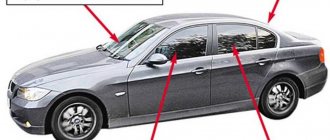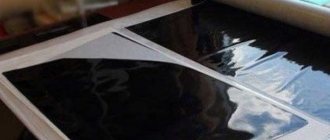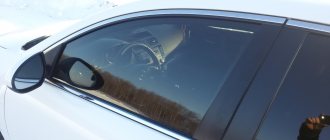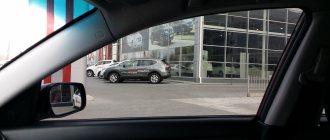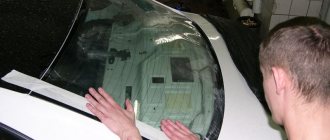- January 9, 2020
- Automobile law
- Inessa Zhebriakova
Every day, inspectors in cities stop vehicles and hold their drivers accountable for improperly tinted front windows. But do traffic police officers have the right to act in this way outside a stationary post?
What should be the rules for measuring tint? How should motorists behave and what should they pay attention to so that their rights are not violated? We will talk about this and much more in the article.
Law allowing tint inspection
The Code of Administrative Offenses of the Russian Federation has an article numbered 12.5. Part 3.1 presents the responsibility for installing color film on the windshield, as well as front side windows, which reduce light transmittance. If the car is equipped with glass that differs from the standard according to technical regulations, this fact will constitute an offense. You cannot drive such a vehicle.
Clause 4.3 of technical regulation 018/2011 specifies the minimum level of light transmission of the side front and windshields - 70%. The law prohibits dark tinting in the form of a film, removable tinting, or “curtains”.
Now all glass is checked in accordance with GOST 32565-2013 “Glass, safe for land transport. Technical conditions".
Fines for tinting sizes in 2019
From January 1, 2019, liability for excessive tinting of windows involves a fine of 1,500 rubles (Part 3.1 of Article 12.5 of the Code of Administrative Offenses of the Russian Federation). By the way, in 2021, the rules that previously allowed traffic police officers to remove license plates for this violation do not apply, citing a ban on the operation of vehicles that do not comply with technical regulations. Today, inspectors can only issue a ticket or force the driver to remove the tint film in order to avoid a fine.
However, the following innovation has already become common practice: in order to combat drivers who repeatedly violate the current regulations on window tinting, inspectors resort to issuing a written warning indicating that the tinting must be removed within 10 days. The next stop of such a violator will result in a higher fine (5,000 rubles). These measures can be challenged if you have a paid receipt for the primary violation, since when stopping again, the inspector begins to be guided by part 1 of Article 20.25 of the Code of Administrative Offenses of the Russian Federation, which provides for the above-mentioned liability for non-payment of administrative fine in due time. Moreover, if the repeat driver really did not pay the fine for tinting according to the previous protocol, he may be subject to not only double fines or arrest, but also mandatory work (up to 50 hours). Note that we are talking not only about windshields, side or rear, but also about headlights. Covered with tint film, they also lose their original qualities, which are no longer associated with the fact that the driver reduces the intensity of road lighting and impairs his visibility at night, but with the fact that the light signals he gives are less visible to other road users.
What devices are allowed for measuring tint?
The device used to check the degree of light transmission is called a taumeter. Now the traffic police uses taumeters marked:
- "Blik-N";
- "Blik+";
- "Tonic";
- "Light".
The error of these devices should not exceed 2 percent. The taumeter is selected depending on the thickness of the glass being tested. All glass up to 7.5 mm thick can be measured with any device, and for glass with greater thickness, “Blik+” is provided.
Maximum permissible level of light transmission
The maximum permissible level of light transmission of car windows is regulated by the technical regulations of the Customs Union TR CU 018/2011 “On the safety of wheeled vehicles.”
In 2021, the standard for light transmission of glass is in force, given in Appendix 8 of the regulations:
4.3. The light transmission of the windshield and windows through which forward visibility is provided to the driver must be at least 70%.
For the side windows of cars, the light transmission rate has not changed in recent years, but for the front windows it has been slightly softened (from 75 to 70 percent), i.e. Now you can make the front window of your car less transparent, i.e. more toned.
What are the requirements for a taumeter?
To measure tint according to GOST, you need to check the taumeter on time. Certification is carried out by the commission on measuring devices. There are some rules that determine the state of the taumeter:
- The certification commission checks the taumeter once every 12 months.
- The person responsible for the inspection puts an individual seal on it and issues a certificate.
- If there are no identification marks on the taumeter, the readings from the device can be considered unreliable. Such results cannot be included in regulations and a fine cannot be issued for them.
- The supply voltage range should be from 11.4 to 12.6 V.
- The certificate can be kept in the traffic police department, and a plate containing the verification date must be attached to the device.
Who has the right to measure the light transmittance of glass?
Road Technical Supervision, as well as any other traffic police officer who has a rank, can check the technical condition of a car. Other services do not have the right to check the level of light transmittance of car windows.
The special rank is regulated by the Law “On Police”. This can be absolutely any traffic police officer from junior to senior management.
The rules for measuring tinting imply checking the level of light transmittance of glass at a police control post, as well as at stationary traffic police posts.
Algorithm for the event
In accordance with the requirements of regulatory and legal sources, the indicator monitoring procedure must be carried out in accordance with a certain algorithm, violation of which weakens the evidentiary value of the protocol:
- providing the car owner with an inspection document confirming the competence of an authorized specialist in the field of conducting the event, as well as a taumeter measurement protocol;
- measurement of environmental indicators that affect the reliability of the result: temperature, humidity, atmospheric pressure;
- cleaning glass from contamination;
- polishing glass until dry;
- measuring indicators by holding the equipment to the glass;
- providing the car owner with the results of research of his car.
How are the survey results compiled?
The execution of the procedure depends on the obtained control results. If the light transmittance parameter meets the regulatory criteria, then a report is drawn up based on the results of the inspection. If discrepancies are identified, a violation report is drawn up and a fine is issued.
Where can control be carried out?
Checking the light transmittance parameter on tinted glass can be carried out at such control points as:
- vehicle checkpoint;
- police checkpoints;
- stationary posts of the state road safety inspection.
When a vehicle is stopped by a traffic police officer outside specialized control points, the driver has the right to refuse to check the light transmission parameters of the windows of his vehicle, even if it is equipped with tinting that clearly violates the standards. The car owner also has the right to refuse to go to a stationary checkpoint, since in order to force him to follow the instructions of the road service representatives, it is necessary to issue an administrative detention, which is inappropriate in this situation, since such a penalty is applied after the violation is detected, and not before it.
Example
The tinting of an Audi vehicle was checked at a stationary control post. Light transmittance indicators were underestimated. A violation report was drawn up against the driver and a fine was issued. The car owner doubted the reliability of the data due to hot weather, which could cause incorrect readings, and filed a complaint with the state inspection service. Authorized representatives agreed with him on the place and time of the re-examination of the light transmittance of the glass.
Weather
Tinting is checked only under certain weather conditions:
- Atmospheric pressure should be within 760 mmHg (+/-30).
- Permissible air humidity is 60% (+/-15).
- The air temperature should vary between 20-25 degrees. Some taumeters can also be used at higher temperatures.
- In winter, air temperatures should not be lower than -10 degrees.
Tinting is not measured in rain or fog. Many people are interested in the question of whether it is possible to check the tint at night. There are no restrictions regarding the time frame - measurements can be taken even late at night.
Classification
The most common devices in Russia for measuring the level of tint, which can often be seen by an inspection inspector, are “Blik-N”, “Tonic” and “Svet”. These types of luminous transmittance meters for automobile glass are approved by Rosstandart. Records about them are included in the State Register of Measuring Instruments (State Register of SI).
Registration of the specified meters in the registry means that the devices have been tested by state testing centers and are approved for use in the Russian Federation. They comply with GOST 51709-2001 on testing methods and GOST 27902-88 on determining optical properties. Verification tests are carried out in laboratory conditions in accordance with the requirements established by the standards:
- temperature Celsius ranges from 15 to 25 degrees;
- pressure from 86 to 106 kPa;
- Relative humidity readings range from 40 to 80%.
Every year, all devices are re-tested by government centers for certification. When measuring with these devices, an error of no more than 2% is allowed. The differences are determined by the ability to work under different operating conditions.
"Blik-N"
For correct operation of the device, a supply voltage of 12 V is required. Tint measurements can be carried out both during the day and at night. The ambient temperature should be within the range from -10 to +40 degrees Celsius. "Blik-N" allows you to measure tint on glass with a thickness of 3 to 10 mm. It is allowed to work at a relative air humidity of up to 95%, but it should be borne in mind that the higher this indicator, the more “Blik-N” can show a larger measurement error. Weight is about 900 g.
"Light"
Unlike the Blik-N device, it has a wider temperature range. “Light” can operate from -40 to +40 degrees Celsius. It also allows you to measure tint at any time of the day. The width of the tested samples must be no less than 3 and no more than 6 mm. Heavier, as it weighs 1 kg 400 g.
"Tonic"
The thickness of the glass being measured should not exceed 20 mm. “Tonic” operates with a supply voltage of 3.6 V. The recommended ambient temperature is from 10 degrees below zero and no more than 40 degrees Celsius. “Tonic” has a small weight of 500 grams. Can work both day and night. The “tonic” is held on the glass manually, therefore, for the accuracy of the readings, the study should be carried out with special care.
How to check glass for light transmittance
The rules for measuring tint provide the following algorithm of actions:
- The inspector measures the current air temperature and humidity, and atmospheric pressure.
- The glass must be wiped until clean and dry.
- You can measure if the device has an error of 2% or less.
- The inspector presents the driver with a certificate or shows a sign containing the date of inspection of the tuamere, a protocol, or a personal document according to which he has the right to carry out measurements.
Operating instructions for taumeter
We will describe the instructions for the most popular device among police officers - “Blik-N”. If measurements are made in the field, it is attached to a strap that is worn around the neck.
To take measurements, you need to connect the device cord to the car's cigarette lighter, which has a 12V power supply. Next, the taumeter warms up for several minutes. If the device is moved from indoors to fresh air or vice versa, the inspector must make sure that the glass on the head of the device has not fogged up or frozen.
You also need to determine which frame is suitable for the glass depending on its thickness. Next, you need to set the device indicator to 100%. If the indicator is unstable, the values on the indicator will flash.
To adjust the apparatus, the receiving and transmitting heads are placed opposite each other on both sides of the glass being measured. It is important to ensure that there is no sudden impact on the glass, since both heads are attracted to each other via a magnet.
If the rules for checking tinting are followed, the indicator will display a number that determines the light transmittance of the glass.
Checking the tool
According to the instructions for using this measuring device, a traffic police officer must prepare it for work by performing the following check:
- Switch the “OFF” toggle switch to the upper position.
- Check the operation of all indicator segments.
- Warm up the operating systems of the meter in idle mode for at least 3 - 4 minutes.
- Select a technological frame from the kit that matches the thickness of the glass.
- Install it between the receiving and transmitting heads. This is done by removing the latter from the device sockets, where they are fixed with magnets.
- Use the control switch to set the readings to 100%.
- When flashing symbols appear, turn them off using the handle.
This process of preparation for work should be carried out before each measurement.
Do I need to go to a stationary traffic police post to take measurements?
If a police officer stopped a driver at a traffic police post and asked him to undergo a check for the light transmittance of car windows, the motorist has the right to refuse to do this, even if the windows of his vehicle are completely tinted.
In this case, the inspector may suggest driving to a stationary post in order to comply with all the rules for measuring tint. Even in this case, the driver may refuse. To force a motorist to go to the inspection point, a police officer must carry out administrative detention. Is this legal?
No, it's not legal. The Code of Contraventions states that it is possible to restrict the freedom of a motorist or any other person only in situations where it is necessary to promptly consider the case of an offense. In this case, detention cannot be used to detect an offense. You can detain a car only if a violation has already been detected, but not before it.
How and on what basis is tinting checked?
Responsibility for the use of color films on the front and windshields with a decrease in the level of light transmission is established by Part 3.1 of Art. 12.5 Code of Administrative Offenses of the Russian Federation. The essence of the offense is driving a vehicle with glass installed that does not comply with technical regulations. At the same time, the law specifies that this violation also applies to colored films on glass, and, more simply, to any tinting.
Technical regulation 018/2011, namely clause 4.3, sets the minimum threshold for light transmission of tinting at 70%. This restriction applies to the windshield and front windows, which provide the driver with visibility when driving. There are also additional restrictions on the use of light-protective strips in the upper part of the glass. But we are now only interested in the light transmission of windows in general and the rules for measuring it in 2021.
Please note that the Regulations do not use any references to GOST. The previously valid GOST 5727-88, on the basis of which traffic police officers checked the light transmission of glass, became invalid as of January 1, 2021 due to the adoption of GOST 32565-2013
Clause 4.7.3 GOST R 51709-2001 and clause 5.7.1 GOST R51709-2001, which motorists like to refer to when appealing the actions of a traffic police officer, copying complaints from the Internet, are also not valid as of 2021.
Clause 7.3 of the List of Malfunctions and Conditions from the Traffic Regulations prohibits the operation of vehicles with the installation of additional items or coating that limit visibility from the driver’s seat. This applies to both tinting in the form of a film and various removable structures - removable tinting, “curtains” and other coverings that limit the driver’s view.
You will also be interested in:
- How to register an LPG with the traffic police? Registration instructions, rules and documents
- Is it legal to tint taillights?
- Is athermal tinting prohibited according to GOST and what is the fine?
Can a traffic police officer's decision be illegal?
Traffic police often take advantage of the fact that motorists have little knowledge of laws and regulations. As a result, few people will challenge a fine of 500 rubles. Here is a list of illegal actions on the part of the inspector:
- You cannot measure the light transmittance of glass “by eye,” even if the inspector “can already see everything.” Even if the glass is heavily tinted, the inspector must check it with a taumeter.
- If the traffic police officer does not have a measuring device, he can simply write out a protocol in which it will be written that there are objects installed on the vehicle that limit visibility. There will be no fine in this case.
- The inspector cannot force the driver to remove the tint without taking measurements.
- If a traffic police officer claims that a car has removable tinted windows, that is, the design of the vehicle has been subject to illegal changes, he must confirm his words through measurements with a device.
